Stateside With Rosalea: Adventure With Pictures
Train Travel, It's An Adventure
Let's not start at the very beginning. It's such a very good place to end. Herewith therefore, the reverse account of a trip from West to Midwest USA.
Chicago, Illinois
Terminal No. 5 at O'Houri International Airport has a photographic exhibition introduced with bluster worthy of the city's boosters who gave the Windy City its nickname when they were trying (successfully) to get the World's Columbian Exposition there in 1893: "This is Chicago. This is America." Chicago's story, the exhibit asserts, is one of "imagination, innovation and boldness: We - invented the skyscraper, were first to split the atom, have won more Nobel Prizes than any city on earth... have a local economy larger than Switzerland and Taiwan.
" Lucky they also have at No. 12 on the list "the world's largest Internet exchange and data transmission port" as the one-hour drive from the city to check in three hours early for my flight to Dublin made the billboard advertising Polycom Video Conferencing - "Because waiting is not working" - look awfully convincing. Chicago is convention city - not just for political ones such as the first Republican convention in 1860, which chose Abe Lincoln as its Presidential candidate, but for every other kind of convention too.
The day I was there it was the World's Trade Fair, being held at Merchandise Mart, a 1930s building that is second only to the Pentagon in the rankings for the largest building in the US. Book your accommodation well in advance.
I didn't and ended up paying $143 for a room with no air-conditioning in a somewhat swanky hotel on the Gold Coast. Its one advantage was the location - within walking distance of the Rush Street pubs and clubs. At 2am when these closed the temperature was 65F and the humidity about 98 percent. Remember what I said about the non-existent air conditioning?
After sun-up it was cold enough to warrant a jacket, especially down at Lakeshore Drive, on the Big Mich. The lake air was "refreshing". So much so that I abandoned any plans to go inside art galleries and museums, for which Chicago is famous, and simply walked about the city instead. My guide was a 1997 Ulysses Travel Guide, chosen because it fitted perfectly in my hand and its layout featured frequent maps with pithy descriptions of the attractions - most of them buildings, because architecture is another of Chicago's claims to fame.
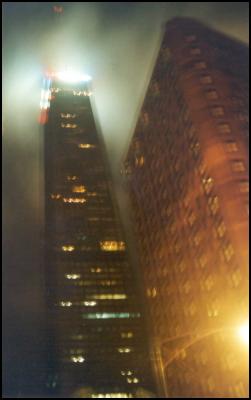
http://img.scoop.co.nz/stories/images/0206/67ffe4feda00bcf474cd.jpeg
IMAGE: The John Hancock Centre and the Palmolive Building at 2am, Chicago.
So it didn't matter that the guide was five years old - the John Hancock Centre hadn't moved an inch. Nor had the Saint James Episcopal Cathedral, which I was passing by, caught a glimpse of the interior and decided to have a closer look at. Turns out Abe the Babe had a similar whim the day after his election to the presidency, when he was passing by with a local congressman.
Brenda Evans, the 84-year-old parishioner who was on visitor duty that day told me Lincoln had always said that the churches lied and he'd never belong to one, but after he got to Washington he joined the Baptists. She was also keen to point out that this was an Episcopal Catholic Church not a Roman one, perhaps because of the bad publicity the latter had been receiving.
The cathedral has a beautiful interior with stencil-work in 26 colours, newly installed bugles and drums above the entrance to give Father Dudley's organ recitals surroundsound, and a bell that chimes the hours and quarter-hours. It is not, of course, the same building Lincoln went into, that having been destroyed like most everything else in the Chicago Fire of 1871.
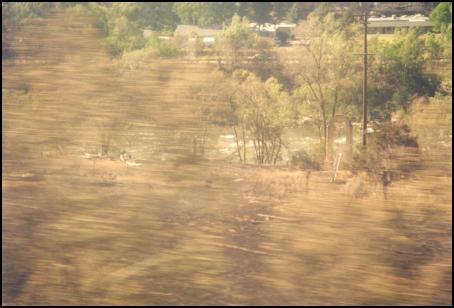
http://img.scoop.co.nz/stories/images/0206/a7dc58c516b158353fe9.jpeg
IMAGE: Glenwood Springs, Colorado. The brown blur is the trees burned beside the track, and the curved doorway just this side of the Colorado River was once a house.
Nebraska and Iowa
Speaking of devastating fires, the train was six hours late getting into Chicago because of the Glenwood Springs fire in Colorado. This meant that I saw in daylight things that are otherwise seen at night as the California Zephyr makes its way across the continent, and also that our Amtrak train often had to give way to freight trains and westbound Amtrak trains, as happened at Burlington, Iowa, which is on the banks of the Mississippi.
We had just gotten over the bridge and no sooner set our butts in the Land of Lincoln than we were rudely ejected, having to back up to let another train through. I'd woken 11 hours earlier at seven in the morning in a funk - Funk, Nebraska to be exact. The great flat plains barely visible above the window ledge of the train, we were trying to make up time and no car was keeping up with us as we went through settlements with their names written on bulbous, leggy water towers, each separated by a million dead-eye straight furrows.
There were no hills anywhere to be seen on any horizon. To spot a slight kink in the roads and irrigation ditches or a missing corn plant was to have more excitement than a body deserved so early in the morning. This early in June the corn was only as high as an elephant's toenail, but should be knee-high by the 4th of July. There was no timber for 200 miles when this railroad was being built, so all the sleepers had to be shipped by trains coming over the tracks already laid.
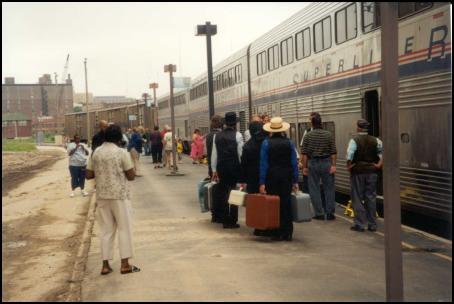
http://img.scoop.co.nz/stories/images/0206/e238b35be1cab3473ecd.jpeg
IMAGE: Omaha Nebraska.
Utah and Colorado
The building of the original transcontinental railroad between Omaha and Sacramento is engagingly told in "Nothing Like It In The World", by Stephen E. Ambrose but much of what the California Zephyr now travels over is track that was built later on a different route. However, when half of Colorado is ablaze the trains again go via Wyoming, as was the case with the westbound Zephyr the previous day.
We were held up in Salt Lake City in the early morning waiting to take on board 25 of those travellers who we were going to points east, and so it was that we got to Denver at midnight instead of 8pm, crossing the continental divide - the Rocky Mountains - in the dark. Like a necklace of blue pearls being swallowed by a magician, the little lights on each carriage of the train went in and out of the tunnels before and after the Moffitt Tunnel at the summit.
It seemed like Beezlebub himself had stayed my course momentarily in Salt Lake City by causing fire to burst forth from the earth at Glenwood Springs, Colorado, setting the forest on fire and burning out the signals, so we could only proceed "under flags" - one train at a time at a pace slow enough to be able to stop if something else got onto the line.
Glenwood Springs has the world's largest naturally heated outdoor pool and is a hub for hikers and skiers, but it is also near the "mountain that burns" - an abandoned coal mine that was sealed off just before WWI because it caught fire and is still burning. You can see where there's no vegetation because the fire is so close to the surface, and it is here that fire burst through.
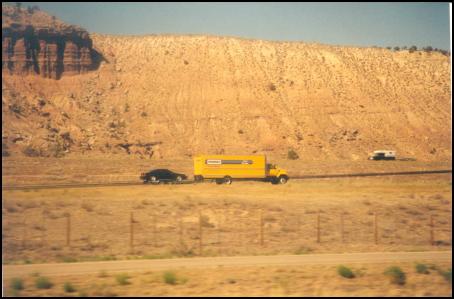
http://img.scoop.co.nz/stories/images/0206/399aa3621a66c55c1f87.jpeg
IMAGE: "I'm towing my car" - heading east through one of the many deserts we go through.
The western end of Colorado is desert, but with many oases of peach orchards and vineyards. But there is no one desert. Even within, say, the Green River desert of Utah there are parts where the tumulus rises roundly up, devoid of all soil, while in the distance the buttes (pron. beauts) have teeth-like cliffs still shedding themselves down the great grey gums they top.
As we go through Thompson, Utah, our coach attendant points out the Silver Grille Cafe, which features in "Thelma and Louise". If you want great views of the Colorado River, you should sit on the right-hand side of the east-bound train, but I rather loved the desert out the left-hand side.
California and Nebraska
At 8pm on the first day we're going through Nebraska and I wax poetic: First the golds then the pinks in the clouds and on the distant hills as we bound across the sagebrush plain. The hills high-shouldered like bison or soft and creased like the pillow of a lover's bended arm.
This land is vast; inside the train you can only imagine what it must be like to stand there, small, alone, invisible. Power pylons dainty as cocktail sticks made from silver-starched lace. It looks like the best place in the world to die - your bones picked clean and bleached by the sun.
The land as flat as a pilled tablecloth. It makes you want to write poems entitled "letter to my unborn self" or "My Catatonia". Nebraska is on the eastern side of that other great mountain range the builders of the transcontinental railroad punched through - the Sierra Nevada. Tunnel 41, aka The Big Hole, is at 7,040 feet and takes four minutes to go through.
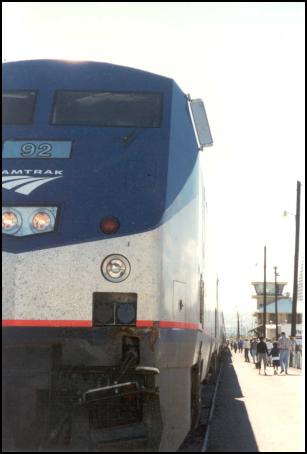
http://img.scoop.co.nz/stories/images/0206/49075d065745803120c0.jpeg
IMAGE: Sparks, Nevada - one of the three big beasties that pull the California Zephyr.
The Chinese building it lived in snow caves and worked on the tunnel from four directions at once, a vertical shaft having been driven down into where the centre of the tunnel would be. It is hard to take this trip for granted, when you consider what it cost in human lives.
Not to mention ox-tails, which got twisted right off in the course of goading the poor animals to drag timber and machinery up the slopes. There is no first-growth timber at all in Cold Creek Canyon - it all went under the rails. In California we go through the site of a 2001 fire that burned 14 thousand acres on both sides of the tracks, seeing a newly built log house that was under construction at the time of the fire and which was saved by the fire fighters putting a line around it.

http://img.scoop.co.nz/stories/images/0206/34eaeb723d20e1ff34e1.jpeg
IMAGE: Emeryville Station.
And in the beginning...
Emeryville. This is where the train starts - if you're coming from San Francisco, Amtrak gets you there by bus. It will take three days to get from here to Chicago, but the scenery is stunning. Well, as far as Denver it is, but the flat midwest is OK too, especially as you get to see the beginnings of the Missouri and the Mississippi rivers. If you want to make this Amtrak trip, you might need to do it before September, which is when Congress decides whether they'll vote it any money to continue.
Lea Barker
Dublin, Ireland
Sunday, 16 June 2002


 Eugene Doyle: The Fall Of Saigon 1975 - Fifty Years Of Repeating What Was Forgotten
Eugene Doyle: The Fall Of Saigon 1975 - Fifty Years Of Repeating What Was Forgotten Peter Dunne: Dunne's Weekly - Trump's Tariffs Still Pose Risks For New Zealand
Peter Dunne: Dunne's Weekly - Trump's Tariffs Still Pose Risks For New Zealand Keith Rankin: Barbecued Hamburgers And Churchill's Bestie
Keith Rankin: Barbecued Hamburgers And Churchill's Bestie Gordon Campbell: On Why The US Stands To Lose The Tariff Wars
Gordon Campbell: On Why The US Stands To Lose The Tariff Wars Eugene Doyle: Before It’s Too Late - Reimagine New Zealand’s Military Future
Eugene Doyle: Before It’s Too Late - Reimagine New Zealand’s Military Future  Binoy Kampmark: Gender Stunts In Space - Blue Origin’s Female Celebrity Envoys
Binoy Kampmark: Gender Stunts In Space - Blue Origin’s Female Celebrity Envoys